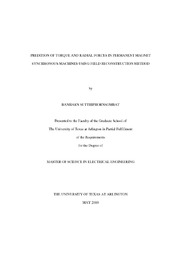| dc.description.abstract | Due to their high torque-to-loss ratio, permanent magnet synchronous machines (PMSM) have received increasing attention in automotive applications over the past decade. Because of this unique characteristics, many applications have utilized PMSM. In addition to high efficiency, quiet operation of the machines is desirable in automotive, naval and military applications. In order to operate at high efficiency quietly, the torque pulsation or torque ripple needs to be monitored and mitigated accurately. Magnitude of the torque ripple is influenced by the magnetic design (cogging torque) and excitation, and the pattern of ripple is affected by the machine's geometry (stator slots).Field reconstruction method (FRM) has been presented and used in this thesis. FRM introduces the reconstruction of the electromagnetic fields due to the phase currents using basis functions and using one single magnetostatic solution from FEA. The implementation of field reconstruction method based on finite element analysis (FRM based on FEA) is performed Matlab/simulink program. Principally, the FRM needs the three-phase stator currents and rotor position of the machine. Next, to accurately calculate torque pulsation, the tangential and normal components of magnetic field, need to be computed. As a result, FRM can correctly calculate the torque of PMSM. In experience, the investigation shows that FRM can accurately calculate the torque pulsation or cogging torque under both balanced and unbalanced operations. Furthermore, the FRM can confirm the effect of torque ripple originated from the geometry of PMSM. In fact, a 12 stator slots PMSM was studied, and the calculation was done by FRM. The resultant torque calculated by FRM shows the accurate calculation of the torque. The experimental results show that FRM can accurately predict the torque. | en_US |

